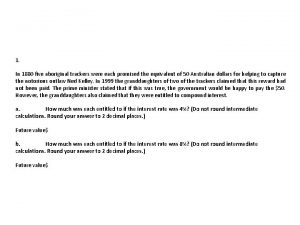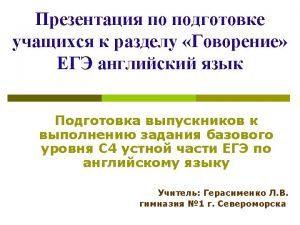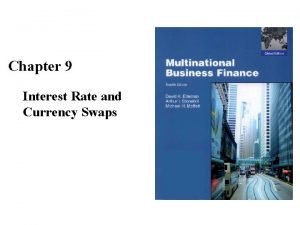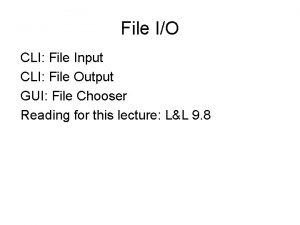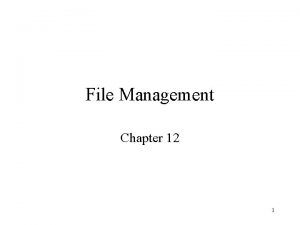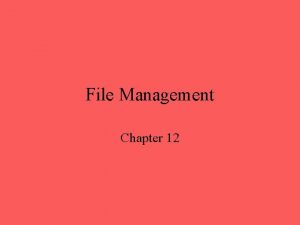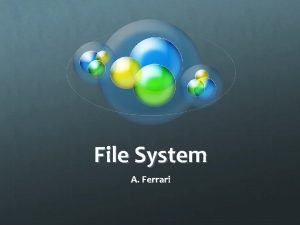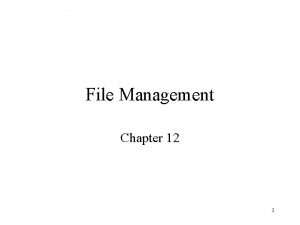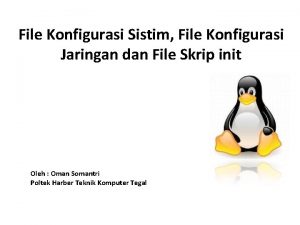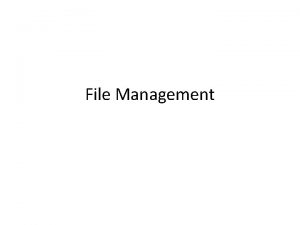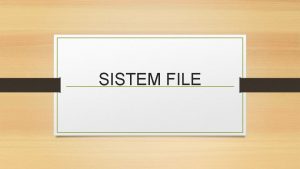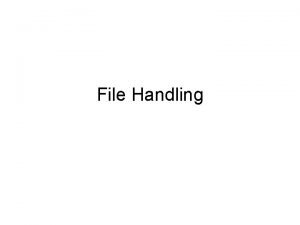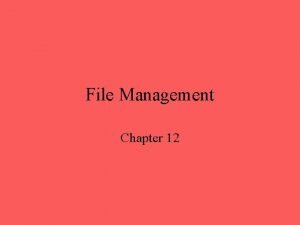Dear users Considering that the dates to file































- Slides: 31


Dear users, Considering that the dates to file the tax returns related to the Colombian Transfer Pricing Regime (CTPR) are just around the corner, Lewin & Wills has prepared this document with the purpose of illustrating the different tax related obligations related to the CTPR. We hope you find this document to be useful. Best regards, Lewin & Wills

Content A. Transfer pricing regime. 1. Arm’s length principle 2. Returns and support documentation a. Transfer pricing information return. b. Support documentation i. iii. Local file Master file Country-by-Country report 3. Penalties B. Controlled Foreign Corporations regime.

A. Transfer pricing • As a general rule, income taxpayers enjoy great freedom regarding the way they arrange their business. However, they must always be careful so that the way their businesses are arranged is not deemed as abusive. • Transactions subject to the transfer pricing regime are those that take place between income taxpayers and their related parties abroad or local parties who benefit from the free trade zones regime. • The transfer pricing regime is a tax policy tool used by the State to prevent the abuse of offshore related parties to improve the financial results of the company eroding the Colombian income tax base.

A. Transfer pricing Example 1 – Without transfer prices • In this case, Col. SAS, sells its products directly to an independent third party (T. I. Ext). Col. SAS $ Description Colombia USA + Income (Sale of goods) - COGS = Taxable Income Goods T. I. Ext. - Tax @33% = Net profit in Colombia Value $3000 <$1200> $1800 <$594> $1206

A. Transfer pricing Example 2 – With transfer prices • In this case, Col. SAS sets up a vehicle in a low tax jurisdiction (VE Ext. ) to channel the operation through it. Description + Income (Sale of goods) Col. SAS - COGS $ Value $1200 <$1200> = Taxable income Colombia $0 - Tax @33% <$0> = Net profit in Colombia Goods VE Ext. $ Low tax jurisdiction Description + Income (Sale of goods) - COGS Goods USA T. I. Ext. = Taxable income - Tax @ 0% = Net profit in Low tax jurisdiction $0 Value $3000 <$1200> $1800 <$0> $1800

A. Transfer pricing • The Colombian Tax and Customs Administration (DIAN) knows of the existence of these schemes and in order to prevent their abuse, Congress enacted, among others, the transfer pricing regime. Therefore, if the DIAN notices a transaction as the one described in Example 2, the most likely outcome is that Col. SAS income tax return would be amended so that the true income of $3000 from the sale of goods sold is included rather than the artificial income of $1200. • As it may be intuited, the purpose of the transfer pricing regime is that income taxpayers who engage in transactions with foreign related parties or users of the free trade regime, determine, for income tax purposes, their income, costs, expenses, assets and liabilities in accordance with the arm’s length principle. • A transaction between related parties is deemed to be at arm’s length it has similar traits as those that would have been agreed upon with or between independent parties in a similar transaction. (See: Art. 260 -2, ET). • All taxpayers engaged in transactions with foreign related parties must comply with the arm’s length principle. Compliance with this principle is the core of the transfer pricing regime.

A. Transfer pricing • Please note that in order to comply with the arm’s length principle only comparable transactions are required; not identical. Pursuant to article 260 -4 of the Colombian Tax Code (CTC), a transaction is comparable when: – There are no significant differences between transactions that can have a material impact in the conditions being considered; or – In case there are such differences, they may be eliminated by making reasonable adjustments. • The following are traits surrounding a transaction that must be considered in order to determine if two transactions are comparable or not: – The characteristics of the transactions that are being analyzed. For example in a financing transaction the following must be considered: the amount of the principal, the interest rate, the time frame of the transaction, the credit risk, the currency, among others. In a transaction involving services, the type of service rendered must be considered, whethere is a transfer of knowledge or not, or if such service requires specialized knowledge. – The functions performed, the assets used and the risks assumed in the transaction. – The terms of the contract. – The economic context that surrounds the transaction. – The business strategy used in order to penetrate, remain or widen the market.

A. Transfer pricing Example about the importance of adequately characterizing certain transactions. Col. SAS $ Colombia Bienes • This transaction may be characterized at least in two different ways: – Characterization 1: Sale of inventories. • In this case, the transaction would be deemed as an income transaction for Col. SAS. • VE Ext. will be held liable for al risks in relation to T. I. Ext. • The analysis of the transaction could take as reference point either Col. SAS or VE Ext. – VE Ext. $ Bienes Baja tributación EE. UU. T. I. Ext. The adequate characterization could have signiicant impact in relation to the transfer pricing penalities regime. Characterization 2: Payment of commissions. • In this case, the transaction would be an expense transaction for Col. SAS. • Unlike the first case, Col. SAS could be held liable for all risks related to the goods sold in relation to T. I. Ext. • The analysis of the transaction could take as reference point either Col. SAS or VE Ext.

A. Transfer pricing • Transfer pricing information return. This return must be filed in the format designed by the DIAN (F 120) (See: Art. 1. 2. 2. 3. 1, DUT). The information that must be provided in this return is the following: 1. Identification of the income taxpayer and of its foreign related parties. 2. Information required to identify all the transactions that were subject to the transfer pricing regime including type of information and amount. 3. Identification of the method used to determine the arm’s length price or profit margin. 4. Information about the profitability index used to determine the market margin. 5. Information regarding the financial information used to conduct the analysis (consolidated or segmented). 6. Explanation about the comparability adjustments made. 7. Statistical information (Min, Max, Median) used to determine whether the transfer prices are within the market range. 8. Information related to the party being analyzed. 9. Value of the income tax adjustments due to the transfer pricing regime. 10. Information about shared costs agreements and business restructurings. 11. Type of relationship. 12. Any other information that the taxpayer deems relevant.

A. Transfer pricing Market analysis Functional analysis Economic analysis Local file

A. Transfer pricing Functional analysis • This analysis is mandatory and in it the taxpayer must identify: 1. 2. 3. 4. Any activity or transaction which may be deemed significant for economic purposes. The functions performed. The assets used. The risks assumed.

A. Transfer pricing Market analysis • This analysis is required provided that it may give a better understanding of the transactions being analyzed. This analysis includes: 1. 2. 3. 4. 5. Description of the industry, business sector or economic activity. Description of substitute goods or services. Economic studies about external shocks that may have had an impact in the transactions under analysis. Description of the business cycle. Any other information deemed necessary.

A. Transfer pricing Economic analysis • This is the core of the local file. It must contain detailed information regarding: 1. 2. 3. 4. 5. 6. 7. All transactions undertaken with foreign related parties. Identification of foreign related parties. Specific information regarding certain transactions (financing transactions or use of intangibles, etc. ) Methods used to analyze the transactions and the reason why each method was used. All information required in order to replicate the economic analysis. Copies of all contracts that gave rise to the transactions subject to the transfer pricing regime. Copies of all advanced transfer pricing agreements entered into by foreign related parties in which Colombia is not a party.

A. Transfer pricing • Only taxpayers that belong to a multinational group are bound by law to file the master file. • A multinational group is any group of two or more enterprises whose tax residence comprises two or more jurisdictions, or that it is composed by an enterprise which is deemed to be a tax resident of one jurisdiction but is liable to tax in another jurisdiction because it has a permanent establishment in the second jurisdiction. (See: Art. 1. 2. 2. 2. 3. 2, DUT).

A. Transfer pricing MG’s intangible assets MG’s intercompany financing activities Description of the MG’s businesses Organizational structure Master File MG’s financial situation

A. Transfer pricing • As it may be seen, the purpose of both the master file and the country-by-country (Cb. C) report is to provide the DIAN with more quality information so that it may better understand the transactions subject to the transfer pricing regime, the taxpayers subject to it and its foreign related parties. • In this sense, the Cb. C report is a global photo which will show were are the profits of the multinational group declared for tax purposes, the taxes paid and the activities it performs. Likewise, the DIAN will have the opportunity to use such information but only for risk assessment in transfer pricing and other areas that may contribute to the erosion of the taxable base. This will allow the DIAN to make a more efficient use of its limited resources.

A. Transfer pricing • Currently only 19 taxpayers have filed the Cb. C report. • Who must file a Cb. C report? – Income taxpayers who: • Are controlling entities of a MG. • Have subsidiaries or permanent establishments abroad. • Are not subsidiaries of another enterprise located in Colombia or abroad. • Have an annual gross income that exceeds 81 million UVTs. – Tax residents or permanent establishments of foreign entities who have been designated by their home office as substitute entity for purposes of the Cb. C report filing. – Income taxpayers who are tax residents in Colombia or permanent establishments in Colombia, and either: • Jointly have the right to claim at least 20% of the gross income of the MG. • Whose controlling entity has not filed the Cb. C report in its jurisdiction of tax residence. • Have an annual gross income that exceeds 81 million UVTs.

A. Transfer pricing Financial information about each of the jurisdictions in which the MG conducts its business. Information about each entity which is part of the MG. Cb. C report 1. The Cb. C report may only be used for risk assessment purposes related to transfer pricing and other conducts which may erode the tax base. The information of the Cb. C may not be used to conduct audit procedures. 2. The information of the Cb. C is confidential as all tax returns in Colombia.

A. Transfer pricing ¿Is the FRP located in a TH or subject to a PTR? YES ¿Type transaction>10 mil UVT? NO of YES ¿Does the taxpayer belong to a MG? YES TPIR + LF + MF NO TPIR + LF NO TPIR ¿Gross equity<100, 000 UVT or Gross income <61, 000 UVT? SI NO ¿Type of transaction>45 mil UVT? NO YES The taxpayer is not bound by law to file any transfer pricing return. 10. 000 UVT = $331, 560, 000 45. 000 UVT = $1, 492, 020, 000 61. 000 UVT = $2, 022, 516, 000 100. 000 UVT = $3, 315, 600, 000 Notation: TPIR = Transfer pricing information return. SD = Support documentation. LF = Local file. MF = Master file. FRP = Foreign related party. TH = Tax haven. PTR = Preferential tax regime.

Support documentation Penalties related with the support documentation (SD). Late filling – Art. 26011(A)(1) Inconsistencies - Art. 260 -11(A)(2) No filling - Art. 26011(A)(3)(a) Note: if the SD is filed before the official assessment is notified to the taxpayer, COGS and expenses will not be automatically rejected. <=5 days: 0, 05% of the transactions without exceeding 417 UVT. >5 days: 0, 2% per month or fraction of a month of the transactions that must be filed without exceeding 1, 667 UVT. This penalty will not exceed 20, 000 UVT. 1% of the transaction filed inconsistently. If it is not possible to identify the base: 0, 5% of the transactions included in the TPIR or of the net income or of the equity included in the income tax return. This penalty will not exceed 5, 000 UVT. 4% of the total value of the transactions with FRP which were not included in the SD. If it is not possible to identify the base, 1% of the transactions included in the TPIR or of the net income or of the equity included in the income tax return. This penalty will not exceed 25, 000 UVT. +COGS and expenses that had to be included in the SD may be rejected.

Support documentation Penalties related with the support documentation (SD). No filling - Art. 26011(A)(3)(b) If the transaction involves a TH ofr a PR the applicable penalties are the following: 6% of the transactions that were not filed in the SD. If it is not possible to determine the base, 2% of the transactions included in the TPIR or of the net income or of the gross equity included in the income tax return. This penalty will not exceed 30, 000 UVT. +COGS and expenses that had to be included in the SD may be rejected. Note: If the SD is filed before the official assessment is notified, COGS and expenses will not be automatically rejected.

Support documentation Penalties related with the support documentation (SD). Omissions (Either partial or total) – Art. 260 -11(A)(4) 2% of the information that was omitted in the SD. If the information omitted does not refer to the amount of the transaction but to other information of the SD, 2% of the omitted information. If it is not possible to determine the base: 1% of the transactions included in the TPIR or or of the net income or of the gross equity included in the income tax return. This penalty will not exceed 5, 000 UVT; but if the value of the transactions that need to be declared is less than 80, 000 UVT, the penalty will not exceed 1, 400 UVT. +COGS and expenses that had to be included in the SD may be rejected. Note: If the SD is filed before the official assessment is notified, COGS and expenses will not be automatically rejected.

Support documentation Penalties related with the support documentation (SD). Omission of transactions involving TH or PR - Art. 260 -11(A)(5) 4% of the information which was omitted in the SD. If the omission is not related to the amount of the transaction but other information of the SD, 4% of the information omitted. If it is not possible to determine the base: 2% of the transactions included in the TPIR or or of the net income or of the gross equity included in the income tax return. This penalty will not exceed 10, 000 UVT. +COGS and expenses that had to be included in the SD may be rejected. Note: If the SD is filed before the official assessment is notified, COGS and expenses will not be automatically rejected.

Support documentation Penalties related with the support documentation (SD). Note 1: Given certain circumstances, the penalities related to the SD may be reduced up to 50%. Amendments - Art. 260 -11(A)(7) If the SD is amended to modify: i)the price or profit margin; ii)The transfer pricing method; iii) The comparability analysis or iv) the range: 1% of the total value of the transactions with a maximum of 5, 000 UVT. If the amendment is made after the special summon or the statement of objections, the penalty will increase to 4% without it exceeding 20, 000 UVT. Note 2: The SD may not be amended by the taxpayer after the official assessment or the penalty assessment has been notified.

Transfer pricing information return Penalities related with the TPIR Late filling - Art. 260 -11(B)(1) <=5 days: 0, 02% of the transactions with a maximum of 313 UVT. >5 días: 0, 1% per month or fraction of a month of the transactions that must be filed without exceeding 1, 250 UVT. This penalty will not exceed 15, 000 UVT. Inconsistencies -Art. 260 -11(B)(2) 0, 6% of the transaction reported inconsistently with a maximum of 2. 280 UVT. Omissions - Art. 260 -11(B)(3) 1, 3% of the amount omitted in the TPIR. When the omission does not refer to the amount of the transaction but to other information included in the TPIR, the penalty will be 1. 3% of the information omitted. If it is not possible to determine the base: 1% of the transactions included in the TPIR or or of the net income or of the gross equity included in the income tax return. This penalty will not exceed 3, 000 UVT. +COGS and expenses that had to be included in the TPIR may be rejected. Note: If the TPIR is filed before the official assessment is notified, COGS and expenses will not be automatically rejected.

Transfer pricing information return Penalities related with the TPIR Omission of transactions with TH or PR - Art. 26011(B)(4) 2. 6% of the amount omitted in the TPIR. When the omission does not refer to the amount of the transaction but to other information included in the TPIR, the penalty will be 2. 6% of the information omitted. If it is not possible to determine the base: 1% of the transactions included in the TPIR or or of the net income or of the gross equity included in the income tax return. This penalty will not exceed 6, 000 UVT. +COGS and expenses that had to be included in the TPIR may be rejected. Note: If the TPIR is filed before the official assessment is notified and the transactions are deemed to comply with the arm’s length principle, COGS and expenses will not be automatically rejected.

Transfer pricing information return Penalities related with the TPIR Note: It is possible for the penalties related to the TPIR to be reduced up to 50% or to be increase by up to 30% (if the taxpayer is forced to include the penalties in the tax return refuses to do so. See: Art. 260 -11(B)(6) Not filling - Art. 26011(B)(5) The taxpayer will be compelled by the tax adminsitration to file the TPIR within a month after it is received. If the return is not filed by that time, a penalty of 4% of the total value of the trsanctions subjet to the transfer pricing regime will be imposed. This penalty will not exceed 20, 000 UVT.

B. Régimen de entidades controladas del exterior Example 2 – With transfer prices; do you remember it? Col. SAS $ Colombia Goods Low tax jurisdiction VE Ext. $ Goods EE. UU. T. I. Ext. • In this case, Col. SAS controls VE Ext. , therefore VE Ext. is considered as a controlled foreign entity (CFE) • By virtue of this, Col. SAS is forced by law to include in its income tax return all pasive income perceived by VE Ext. • Pasive income includes, among others, income from the sale or purchase of tangible assets que fulfil all of the following: – The assets are acquired from or sold to or on behalf of a related party. – The assets are produced manufactured, built, cultivated or extracted from a different jurisdction to that in which the CFE has its tax residence or is located. – The use, consumption or disposition of the assets is done in a different jurisdction to that in which the CFE has its tax residence or is located.

Disclaimer This presentation was prepared with the purpose of ilustrating the generalities of the Colombian transfer pricing regime and of the Colombian controlled foreign entities regime. Therefore, it is not an advice nor a legal opinion about the two regimes just mentioned. Therefore, Lewin & Wills does not assume any responsability or liability for decisions made considering this information.

 File-file yang dibuat oleh user pada jenis file di linux
File-file yang dibuat oleh user pada jenis file di linux Thơ thất ngôn tứ tuyệt đường luật
Thơ thất ngôn tứ tuyệt đường luật Tôn thất thuyết là ai
Tôn thất thuyết là ai Phân độ lown
Phân độ lown Walmart thất bại ở nhật
Walmart thất bại ở nhật Gây tê cơ vuông thắt lưng
Gây tê cơ vuông thắt lưng Block nhĩ thất độ 2 mobitz 2
Block nhĩ thất độ 2 mobitz 2 Tìm vết của đường thẳng
Tìm vết của đường thẳng Sau thất bại ở hồ điển triệt
Sau thất bại ở hồ điển triệt Thể thơ truyền thống
Thể thơ truyền thống Hãy nói thật ít để làm được nhiều
Hãy nói thật ít để làm được nhiều Physical image vs logical image
Physical image vs logical image Fungsi dari create file pada operasi-operasi file (cont.)
Fungsi dari create file pada operasi-operasi file (cont.) Distributed file system
Distributed file system In a file-oriented information system, a transaction file
In a file-oriented information system, a transaction file Markup tag tells the web browser
Markup tag tells the web browser Imperial jewelers is considering a special order for
Imperial jewelers is considering a special order for The holiday meal turkey ranch is considering
The holiday meal turkey ranch is considering Johnny's lunches is considering purchasing a new
Johnny's lunches is considering purchasing a new Types of advertisement
Types of advertisement You are considering buying some flowers
You are considering buying some flowers Rhetorical situations definition
Rhetorical situations definition Considering interestrate swaps, the swap rate is
Considering interestrate swaps, the swap rate is Thiếu nhi thế giới liên hoan
Thiếu nhi thế giới liên hoan Sự nuôi và dạy con của hổ
Sự nuôi và dạy con của hổ điện thế nghỉ
điện thế nghỉ Một số thể thơ truyền thống
Một số thể thơ truyền thống Công thức tính độ biến thiên đông lượng
Công thức tính độ biến thiên đông lượng Hình ảnh bộ gõ cơ thể búng tay
Hình ảnh bộ gõ cơ thể búng tay Số nguyên là gì
Số nguyên là gì đặc điểm cơ thể của người tối cổ
đặc điểm cơ thể của người tối cổ Fecboak
Fecboak


















